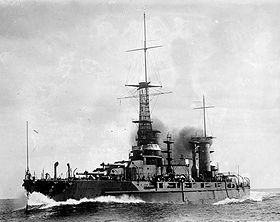Rivadavia (ship)

|
|
|---|---|

|
|
| Overview | |
| Type | Battleship |
| Shipyard |
Fore River Co., Quincy, Massachusetts |
| Order | 1908 |
| Keel laying | May 25, 1910 |
| Launch | August 26, 1911 |
| delivery | August 27, 1914 |
| Removed from ship register | 1956 |
| Whereabouts | Sold February 8, 1957 to Ardemsa, Genoa, where it was scrapped from May 1957 |
| Technical specifications | |
| displacement |
Normal: 27,940 t |
| length |
L pp : 178.3 m |
| width |
30 m |
| Draft |
8.5 m |
| crew |
130 officers and 1,000 men |
| drive |
|
| speed |
22.5 kn |
| Range |
7000 nm at 15 kn |
| Armament |
|
| Armor |
|
| Bunker quantity |
4000 tons of coal and 600 tons of heating oil |
The Rivadavia was an Argentine battleship ( Acorazado , Spanish literally "armored") and the type ship of the Rivadavia class, to which the Moreno also belonged. In construction, the Rivadavia was similar to the Arkansas and had a lattice mast typical of US battleships . It was named after the first president of Argentina, Bernardino Rivadavia (1780-1845).
Historical background of the construction
After Argentina had settled a naval arms competition with Chile , which had arisen as a result of border disputes, in May 1902 by means of a treaty, and both states then canceled purchase orders for larger warships abroad, Brazil developed an ambitious naval armament plan, which became one through the so-called dreadnought leap in 1905 received a certain dynamic. Brazil ordered the two dreadnoughts Minas Geraes and Sao Paulo in Great Britain , which Argentina met with a construction contract for two dreadnoughts in the USA. When Brazil ordered a third battleship in Great Britain, plans to buy another ship in Argentina were also planned. The purchase could be dropped when it turned out that Brazil was overwhelmed with the financing of the project. In any case, the Brazilian armaments for the “Golden Fleet” (Armada da Oro) had placed an extremely heavy burden on the state budget. The Superdreadnought Rio de Janeiro , already under construction in Great Britain , was sold to the Ottoman Empire , the ship was confiscated by Great Britain at the outbreak of World War I and put into service as HMS Agincourt .
Period of service and retirement
Since Argentina remained neutral in both world wars, the battleships were never used militarily. In 1925/26 they were thoroughly modernized in the USA. In addition to the front lattice mast, the ships received a three-legged mast at the rear. In January 1937, both ships called at Valparaíso in Chile and Callao in Peru on a major voyage abroad . Later in the year they visited Brest and Wilhelmshaven together . The two units separated in Wilhelmshaven and the Rivadavia visited Hamburg , the Moreno Bremen . From October to December 1946 the Rivadavia visited Mexico , Cuba , the Dominican Republic , Venezuela and Colombia on the orders of President Juan Perón .
In 1952 both ships were decommissioned and dismantled. In 1957 it was sold to an Italian scrapping company. In 1960/61 the Rivadavia was scrapped in Savona .
See also
literature
- B. Weyer: Taschenbuch der Kriegsflotten , XV. Born 1914, Munich 1914, Reprint Koblenz 1983, p. 20 u. 164.
- Alexander Bredt (ed.): Weyers Taschenbuch der Kriegsflotten , XXXVI. Born 1943/44, Munich / Berlin 1944, 3rd new edition. Bonn 1996, p. 16 u. 308
- Adrian J. English: The Armed Forces of Latin America. Their Histories, Development, Present Strength and Military Potential , 2nd ed. London 1985, pp. 38f.
Web links
- Historia y Arqueologia Marítima. Acorazado ARA Rivadavia (1914). histarmar.org.ar, accessed on November 14, 2010 (Spanish, various images of Rivadavia ).
- LAUNCH RIVADAVIA, BIGGEST BATTLESHIP. ( PDF, 134 KB ) Argentina's Powerful Fighting Machine Takes Water at Fore River Amid Cheers. In: NY Times Archives. The New York Times , September 27, 1911, accessed November 14, 2010 .